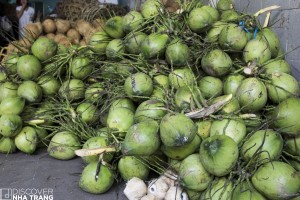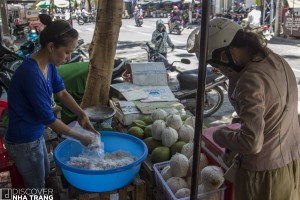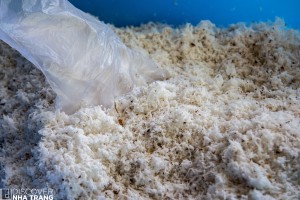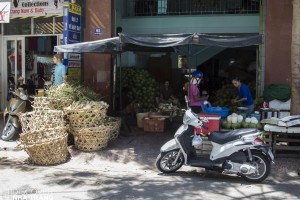“They were here when I was a little girl
The coconuts lulled me into the sweetest dreams
Each time, when they sing in the rush of wind
I ask my grandma: “When were they born?”
And she says: “Since I was a little girl”
The coconuts have been in front of the yard.”
“Coconut” – A poem by Le Anh Xuan
Whenever we think of heaven, we look up to the sky. Here in Vietnam, we often find the spreading fronds of coconut palms blocking our view of the heavens above. Although the origin of coconut is unknown, this husky tropical fruit has been a part of our lives since time immemorial.
The coconut has become not only an irreplaceable ingredient in culinary culture, but is a vital part Vietnamese spiritual and family life as well. Vietnamese children grow up eating sweet coconut candies, get married with coconut “Husband and Wife” cakes placed on wedding trays, and enjoy cozy family dinners with meats stewed in delicious coconut juice.
It cannot be denied the coconut has a taste of heaven; its delectable flesh providing a nutritious and beautiful flavor. Throughout the ages, coconut water has been used as a refreshing drink and an ingredient in traditional Vietnamese cuisine. Women use its oil to shine their hair while the green shells are used to wash wounds, burns and sores. In cases of extreme emergency, coconut water has even been used as a replacement for blood transfusions! Nowadays, coconut can be refined and produced as coconut cooking oil, a low fat, tasty alternative to vegetable oils. This oil can also be used to produce biodiesel, a ‘green’, carbon neutral alternative to fossil fuels.
The coconut has long been associated with many cultures across the globe. It gets its name from the Spanish word “coco”, which means “skull”. That’s probably because its hard shell reminds us of the human head. Providing useful material and food from husk to flesh, the coconut provides employment and income to countless people involved in the various processes of turning a simple coconut seed into the drink at your beachside table or the milk that provides the smooth creaminess to your coconut curry.
- Thousands are sold each day across the city
- Preparing Coconut Flaskes
- Close up of Coconut Flakes
There are two main species found in Vietnam; Dua Xiem and Dua Bung (Dua means coconut), with both varieties found in almost every Vietnamese kitchen. The bigger one, Dua Bung, is generally used in cooking because it contains a lots of water, while Dua Xiem is the best choice to experience that real taste of heaven. Although smaller than Dua Bung, the water is much sweeter, making it ideal for a coconut drinks and cocktails.
A perfect location to buy the freshest coconuts in Nha Trang is Tiem Dua, a local specialist coconut shop that has been in business for over thirty years. Located at 92 Bach Dang Street, it is one of the biggest shops of its type in the city, run by a second generation brother and sister team, Ms. Oanh and Mr. Phuc, who inherited the family business from their father. Never wanting to let him down, they always provide their customers the best quality coconuts.
Serving not only coconut water, but also coconut milk and flakes, their typical day is long and arduous. Rising at 2am to receive produce from their suppliers, they will usually finish well after 8pm, and often cannot remember how many coconuts they have sold during the day. Responsibility, earnestness and dedication are values instilled in them by their father, and they approach each new working day with these lessons in mind.
While Oanh and Phuc represent just one section of an entire industry based around coconut farming, distribution and consumption, there are many others who rely entirely on this amazing fruit to generate their incomes. Their daily lives and fortunes remain forever intertwined with the life cycle of the coconut palms.
- Tiem Dua Bach Dang Street
- The lovely Ms Oanh
- working through the coconut pile








Leave a Reply